#Balkan slave trade
Explore tagged Tumblr posts
Note
Hi,
Can I ask your opinion? There is one YouTuber who is lives Spain and USA and he sounds quite basic. Thing that makes me think is that he says that ottoman and Arab slavers weren't as bad as Atlantic slave trade. Reason for that was because slaves can earn their freedom and their children weren't slaves and after they get free they lived part of society etc. He says that best way to find information treatment of slaves is people who own them. What is your opinion of this? Like I know how Balkans they tattooed girls to keep the safe and captured young boys were convert to islam and rise soldiers.
"that best way to find information treatment of slaves is people who own them." oh, really? Let's go read old WASP's accounts of their Black slaves. I'm sure they will be very reflective of the truth, right? 😂😂 It's all "please look at the perspective of the slaves!" until the slaves are European, apparently.
I think this whole discussion of "Arab slavery wasn't that bad" is a way to minimize an extremely wide and despicable slave trade that lasted for more than A THOUSAND YEARS (and still hasn't ended). In comparison, slavery in America lasted from the 17th to the 19th century. (400 years if we are generous)
Also, I'm sure they would change their tune once they learned that "Brown" and "Black" people too were taken as slaves in this slave-trade. Especially "Black" people were taken a lot and in rural areas they were forced to work in the hardest of conditions, often not living more than 5 years.
I will link videos below that mention all the countries where slaves were taken from, reviewed by Black African women. But I will focus here on Europe because that's what USians have in mind when they say "it wasn't that bad".
Whole villages were taken. Villages. For centuries on end. The sheer amount of people who were taken is scary. We are talking about large populations that changed the genetic makeup of certain areas. And we have veeery few accounts of these people earning their freedom. Just because they legally could, it doesn't mean their "masters" let them.
Families were separated. They were killed when they were trying to escape. They could be beaten and lashed at any moment, for any minor inconvenience they created for their "lord". Yes, there were house slaves, too, like in transatlantic slavery, but they were also made to work under extreme conditions (e.g. extreme heat). They were working in plantations and in mining, things that the free people wouldn't do themselves.
They were castrated. They were raped and often carried the child of their rapists. Through these rapes, many children were born and mothers tried to hush this fact and hide it from future generations. Being seen as an "exotic commodity" isn't the flex these people think it is. Being a "white breeding mare" the pirates went all the way to Norway to capture, isn't a flex.
A White woman cost higher than a Black woman (racial discrimination against Black people that spread in other areas too) but that meant that European women were hunted down intensely and they had almost no chance of escaping captivity through ransom. It was more profitable to be sold, than to be returned with a ransom paid by their families or foreign countries. Arabs "preferred" non-Black slaves, and so many non-Black slaves were taken for many centuries. A double-edged sword, because you don't exactly want a slaver to "prefer" your "race" for any reason.
And if you think that highly sought enslaved women in the "entertainment" industry weren't frequently abused or raped, you can look at the abuse numbers of free women in the entertainment industry today...
People born from rape during slavery were much more than we think. Having to "ruin yourself" with tattoos (according to your tradition) and raise your child as another gender, speaks volumes of the lengths people went to avoid a very frequent phenomenon. The Greek revolution against the Ottomans clearly stated "we don't want to be taken as slaves anymore! We prefer one hour of freedom over 40 years of slavery!" In many cases, the slaves were outright called "chattel"!
Taking the male population as children is also looked by the outsiders as "good" because "they lived in good conditions and they were educated" but please go tell that to the mothers who never saw their children again. These children were also stripped of their culture and religion and language, and were often employed to oppress and kill their own people. Many Balkan countries have songs about this phenomenon.
This slave-trade was totally legal and acceptable within the Ottoman and Arab empires but it was also pirating activity that supplied the slave traders. It was mostly the Beber nations but many Africans, and West Asians and Arabs in the Arab peninsula benefited from it. They often took part in the "stealing people" operations. For example, the most exposure to Black people Greeks had was when they saw them as pirates in Arab ships. That's why the slur for a Black person in Greece historically is basically "Arab".
Europeans were building WALLS toward the sea to prevent these attacks. (Ironically, some were built by the same government that took their subjects as slaves) Thessaloniki had these walls, for example. Like, I'm not sure if the USians who often compare the slave trades ever thought of having a wall towards the sea as a normal thing. Some European nations still have sayings like "there are no Moors at the coast" as another way to say "all is safe". That's how much the trauma has stuck.
In the video linked below, there's also mentioned a revolt towards an Ottoman leader because "why won't you let us have slaves from Europe??" Does this conflict ring a bell, fellow US-ian friends? 😂
European nations and the US had created TREATIES with African states (which didn't stop the attacks in many cases) as an effort to basically say "ok, stop taking our people! we will pay you!" The amounts paid were extravagant but they were still small in comparison to how many people (and profit lol) would be lost otherwise.
There were a few cases where a slave could free themselves in the Arab slave trade but this was the case in the American slave trade too! Legally slaves in the Americas could be freed if their master wanted it, if they paid off their master, or if they were illegally enslaved. They could also have court cases to win their freedom, or serve in the military in exchange for freedom. Some were allowed to have side businesses and earn their own money (and eventually pay for their freedom).
We know there were such cases but, as I mentioned above, just because it is the law, it doesn't mean that it happened a lot.
An American would tell you "noo! Despite some legal protections it was still horrible!" and I'm asking, why don't you say this for the millions and millions of slaves in the Arab slave trade when it comes to laws VS actual treatment?
"their children (the children of slaves) weren't slaves". The recorded history shows that they usually were slaves, though. A minority, if lucky enough, could gain freedom while being born a slave. But slaves were often lumped together in certain areas so they had children with other slaves. And even children by free men often were considered slaves, unless the free male master decided to recognize them.
Just because it isn't Louisiana weather and just because the slaves (usually) didn't die on the way to their destination, it doesn't make it less atrocious. There was a reason our traditions speak of people killing themselves before they could get captured into slavery.
Like a gay Greek man said the other day "we are not supposed to be thankful just because you're not dragging us on the streets and stoning us". The laws saying "Provide shelter, and healthcare and don't mistreat your slaves" doesn't mean this was followed. "Shelter" could be a dirty shed. "Medical attention" could be splashing some water on the wounds from the lashing. "Don't overwork them" could be "I work them too much but not to death, so it doesn't count."
The video speaks more about the white slave-trade of US people but it's good to note how this looks "mild" (for lack of a better word) to what was happening in Europe. I'm not saying this as "these slaves had it better compared to the European ones". No. I'm simply saying that the danger and frequency were much larger for European people, mainly those who lived in coastal nations.
youtube
This video focuses on other areas, mainly in Africa, where slaves were frequently taken from.
youtube
39 notes
·
View notes
Text
So... I'm about to write something messed up, that I learned today and I'm freaking out. If you're from balkan and you knew this please message me and explain how.
I was on wikipedia, reading the page 'Human' because I was curious what it said, and honestly that article is unhinged and sounds copied from an alien textbook. It goes over the history of human development and at one point starts going over slavery and I accidentally clicked on 'atlantic slave trade'. Since the page was open, I thought, why not learn more about this, always good to know about history of slavery since it set the world up into what it is today.
So I am reading, and it explains how big empires relied on slaves to produce sugar, cotton, and other commodities, and at first trafficked and sold people from Africa for this, but then also incorporated religion as a judgment of who can be a slave. So they weren't supposed to enslave people of their own religion, but could enslave someone they believed to be a heretic. Catholics were enslaving orthodox christians and muslims could enslave shia muslims.
I am reading this and thinking how religion is even more evil than I originally thought and this is disgusting and then I read the words 'balkan slave trade' and I'm just ????. Like what do you mean. I know I havent paid attention in history but come on. That I would surely remember?
So I click it, and find out. In 14th century, balkans were pagans, and there was also 'Bogomilism' religion which meant 'dear to god' and it was anti church, gnostic practice that went against christian hierarchy. Since balkan was on the religious borders of christianity and islam, they were allowed to be taken slaves and were trafficked via port in Dubrovnik. The pagan religion of balkan was the confirmation of their slave status, and Bosnians were most aggressively targeted. Women were trafficked to be house help in Italy, while males were turned Egyptian soldiers. The practice stopped when Ottoman empire claimed balkan in 15th century at which point the slave trade was absorbed into the ottoman slave trade.
I've never even heard of any of that before. I'be been mad about destructiom of pagan religion for years but they actually enslaved and trafficked pagans? I didn't know.
Then I wondered why I didn't know, and asked wikipedia to show me the same article in croatian language. It didn't exist. In fact, the article only existed in english language. I then googled 'balkan slave trade' in croatian. Zero results. Nothing. It wasn't that I didn't pay attention, there are no sources about this written in my language!
We just DON'T TALK ABOUT THIS??!!
Was the only way for me to find out a miniscule chance I stumble on it accidentally on wikipedia? I need more info. Who knew about this and why is it hidden. I need to know everything. I want to understand why things are the way they are.
#Pagans#Bogomilism#Balkan slave grade#Slavery#History#This post looked weird bc my laptop is dead#And i typed it on phone#And sent it in email#And copied it wrong
113 notes
·
View notes
Text
damn this cracker is fire 🔥🔥🔥🗣
Look at rastkos new horns

#do white people from places completely unrelated to the slave trade still count as crackers...#i cant imagine the balkans were very involved... i should look that up
10 notes
·
View notes
Text
me: tattooing predates the slavic migration in the balkans
least racist jugoslav: OH SO YOU SUPPORT THE OTTOMAN SLAVE TRADE???? YOU SUPPORT TURKS IN WOMENS SPACES?????
17 notes
·
View notes
Note
[Huey Zoomer Anon]
You the whole attacks on Jewish people…tbh there was several signs the left never gave a damn about indigenous or marginalized people.
Shall I use Woman King as example?
“Oh Hollywood finally using a proper African kingdom and not the Pan Africa bs that interesting- African Americans to the Dahomey is WHAT?!”
The thing that piss me off the most that a bunch of white people knew that shit vs me who descended from the victims of the Dahomey slave trade
Also how many African Americans education professors knew about the Dahomey for decades but purposefully left that out in our curriculum?
Also yes I know the Yoruba tribe (the primarily genome of African American diaspora) had an empire and slave system too. We are all descendants of murderers and thieves
Also I heard the Bantu tribes are second more common genome in my people disporia, though more common in like Louisiana. Didn’t the Bantu create the Mali Empire?
There a creole/Manu masa joke somewhere…
But thing is that the left idea for indigenous is the Hollywood Stone Age noble savage. Because indigenous people can’t modernize themselves to contemporary times?
Wait I think I hear fuckton of tribes in the americas, India, Asia, and Africa screaming in rage.
Well at least a good chunk of Jewish people prepared themselves for when the world turns against them for round #27421973135852197324752247744842!
Ugh they gave the world so many gifts despite the pain humanity inflicted upon them. Yet still the world still prefer weeping for the dead Jews and despise those who are still alive
You the whole attacks on Jewish people…tbh there was several signs the left never gave a damn about indigenous or marginalized people.
Dakota access pipeline protest, didn't want a oil pipeline because it would polloute.

Which even if they hadn't trashed area they're dumb anyhow, the oil is gonna get moved, without the pipeline it's getting moved by truck which not only pollutes more it also costs more in the end.
Also how many African Americans education professors knew about the Dahomey for decades but purposefully left that out in our curriculum?
Depending on the level they're teaching at it could go from very few of them to most of them, I'd hope some of the college ones would have included the whole thing but not sure how much that hope is worth at all.
Wonder what the 'middle eastern studies' Profs in colleges taught about all that too, there's obscenely wide gap in the high and low estimates of number of black African slaves that were brought into the area through the Arabic slave trade, nobody really kept records of the numbers there like they did with the trans Atlantic slave trade.
Arabic one ran longer and in all likelihood had a way higher number than the one bringing them here to the Americas, that and them raiding the european coast to pick slaves up or the stealing children from their parents in the Balkans as a form of a tax and then forcing them to fight in the sultan's army.
Also yes I know the Yoruba tribe (the primarily genome of African American diaspora) had an empire and slave system too. We are all descendants of murderers and thieves
Sooner folks accept that the sooner we can move forward more as a species.
Also I heard the Bantu tribes are second more common genome in my people disporia, though more common in like Louisiana. Didn’t the Bantu create the Mali Empire? There a creole/Manu masa joke somewhere…
I don't know about that one so I couldn't say,
But thing is that the left idea for indigenous is the Hollywood Stone Age noble savage. Because indigenous people can’t modernize themselves to contemporary times?
Whole thing is wild because I see places all over the world where they engage in some traditional celebration with all the trappings including food and dress and activities and all that good shit and then when that's all done they return to current year.
Culture and history celebrated while still remaining in current year
I hate all the noble savage crap.
Well at least a good chunk of Jewish people prepared themselves for when the world turns against them for round #27421973135852197324752247744842!
Ya, there's a whole 'we've got nowhere left to go' mentality added into the 'this is our homeland' one they've got that's got them constantly on their guard and in a state of readiness.
Ugh they gave the world so many gifts despite the pain humanity inflicted upon them. Yet still the world still prefer weeping for the dead Jews and despise those who are still alive
It really does feel that way at times for sure.
Wonder what the name for a prejudice like that is, nit just Jewish people it happens with after all.
5 notes
·
View notes
Text
By: Keith Woods
Published: Jul 2, 2023
A look at slavery outside of the West
It has become popular to blame White people for slavery, to the point that many actually believe slavery was invented by or exclusively practiced by Europeans.
But the history of slavery outside the West is far more brutal.
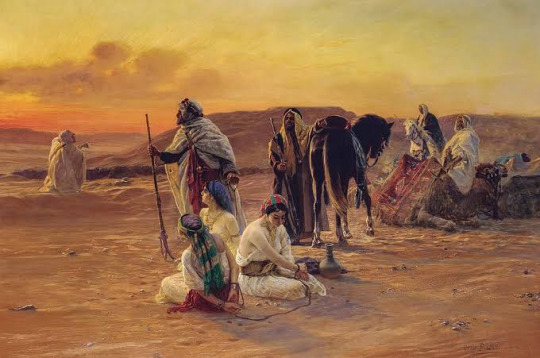
The Arab slave trade emerged in the 7th century, 10 centuries before the Atlantic slave trade
Arabs sold Africans to the Middle East for a variety of jobs such as domestic work or harem guards - castrating male slaves was common, causing over half of males to bleed to death

The Arab slave trade was particularly brutal: it's estimated that 3/4 captured slaves died before they reached the market for sale
Historians estimate that between 10 and 18 million people were enslaved by Arab slave traders, including women and children taken as concubines.
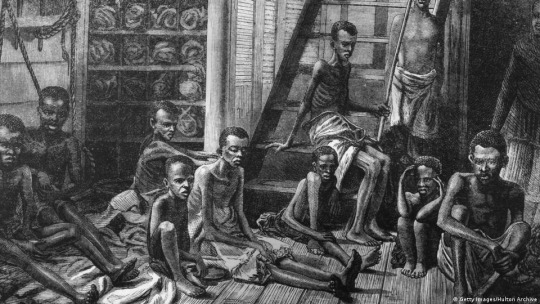
Arabs did not create the slave trade out of nothing, in fact, enslaving conquered tribes was already common practice in Central Africa when they arrived.
The West African Songhai Empire relied heavily on captured slaves in all levels of society, even as soldiers.

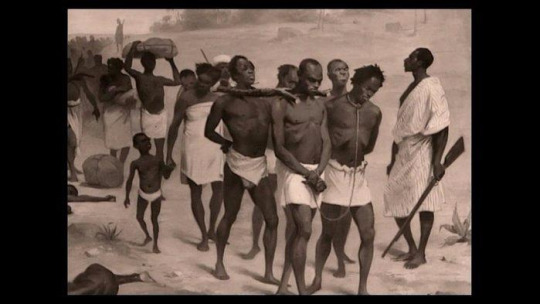
Africans themselves also played a large role in facilitating the trans-Atlantic slave trade.
African tribes conducted raids on rival groups to provide slaves for sale. African middlemen facilitated trade between European traders and African suppliers.



The Arabs also had a slave trade in Europe. Estimates are that up to 1.25 million Europeans were enslaved by Barbary pirates, who would raid villages in coastal countries like Italy, France, England and Ireland, bringing them to North Africa for sale.
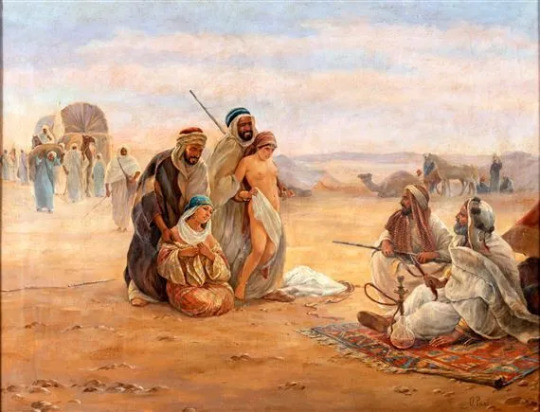
In some cases entire villages would be captured, such as the Irish coastal village of Baltimore, entirely raided in 1631.
These slaves faced a brutal future, engaging in hard labour or sexual servitude, and spending nights hot and overcrowded prisons called bagnios.



Many slaves captured by Barbary pirates were sold eastwards into the Ottoman Empire. Slavery was central to the Ottoman Empire, most towns had dedicated slavery markets called Yesirs.
Slaves came from Africa, the Caucasus, the Balkans and Eastern & Southern Europe.

Sexual slavery was a big part of Ottoman society. Slavic women were popular slaves, and Köçeks became a popular source of entertainment in the 19th century:
These were young boys, usually from European backgrounds, who were circumcised, cross-dressed and trained as dancers.


Hereditrary slavery is recorded in China dating back to the Xia Dynasty in 2100 BC. Africans purchased on the Silk Road were used as a sign of wealth.
After Chinese law began to treat women as property around 1000AD it was common to sell daughters and sisters into slavery.
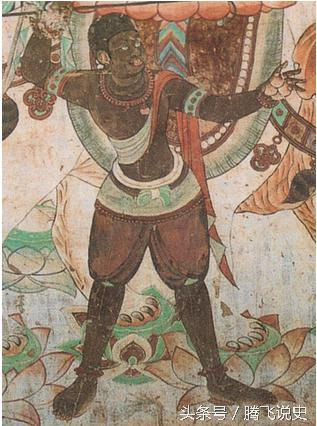

The Mongols enslaves tens of thousands of Chinese as punishment for resistance.
In the post-Mongol Ming Dynasty, thousands of slaves were employed to do bureaucratic jobs for the government, and rich families also employed thousands of slaves to perform menial labour.
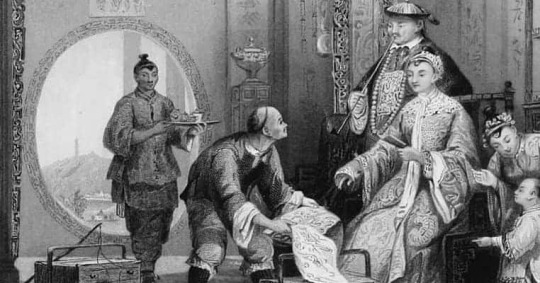
Slavery was common in American civilizations like the Aztec and Maya
Among the Aztecs, slavery was a punishment for a variety of crimes or even failure to pay taxes. Husbands and wives sold each other in times of economic hardship. Slaves were identified by wooden collars.
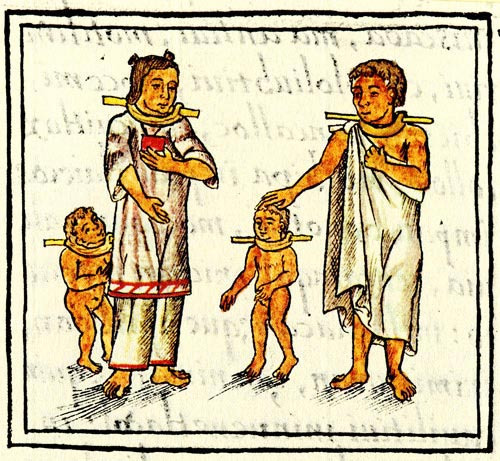
Slavery was also common practice in the civilizations of South-East Asia.
The Khmer Empire had a massive slave class that did much of the work building monuments like Angkor Wat. Historians estimate 25-35% of the population of Thailand/Burma were slaves in the 17th century.
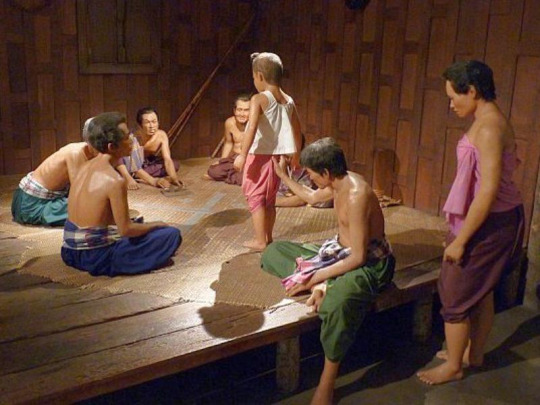

Slavery also existed among Native American tribes. Slavery was common practice among Northwest tribes like the Tlingit, for whom one third of their population during the mid-1800s were slaves.
Various tribes practiced debt-slavery and enslaved captives of other tribes.
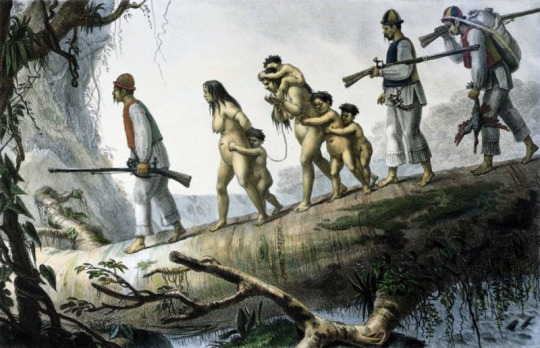
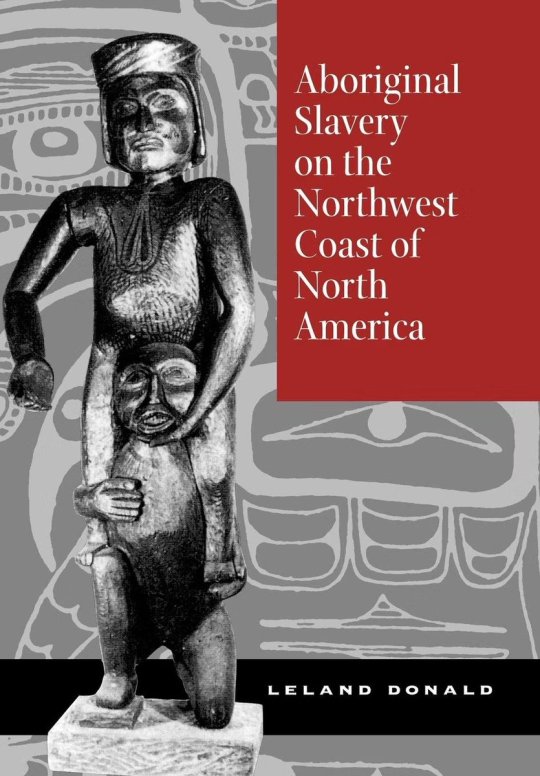
The only difference between these cases of slavery and that practiced by Europeans is that Europeans abolished slavery on humanitarian grounds, and spread this across the globe.
The intense focus on the White role in slavery is a product of widespread Anti-White animus.

==
American exceptionalism comes in two varieties: "we're exceptionally virtuous," and "we're exceptionally evil."
Both rely on lying about or being ignorant of history.
https://www.nationsreportcard.gov/dashboards/schools_dashboard.aspx

And that's just American history. Can you imagine world history?
#Keith Woods#slavery#history#history of slavery#exceptionalism#American exceptionalism#inverted exceptionalism#religion is a mental illness
26 notes
·
View notes
Text
Stay Hungry
There is one person whose hunger had changed the world forever. He is someone who abolished slavery and got assassinated. He is none other than Abraham Lincoln, a man who is a great epitome of staying hungry for his goals. He was a lawyer by profession. He was born in 1809 near kentucky.His Journey started at the age of 15 years.When he was passionate about Law.He had no money to buy the books. By looking at his zeal, someone suggested him to cross the river and on the other side , there was a barrister who lives there. So, He started his journey by riding the boat but while crossing the river, his boat got flipped. But he did not lose hope. Here comes stay hungry Philosophy came into play. Despite of heavy river flow and danger, he crossed the river . and he turned to Barrister house. First,barrister refused to share his books. By looking at his not giving up attitude, he allowed him to read his books and in return, he had to do all the home chores work.He did and like this, he became a lawyer.. His First wife died at the young age. He married second time to mary todd . They had 4 children out of which 3 died. He was in depression all his life because of this. He entered into politics, he lost most of the elections in his lifetime.You can also read about sania nehwal who is a great example of sportsman spirit.
Despite of having hunger in him, he was elected as president of USA in 1860. His presidency was tough but had changed the world forever. At the time, Slavery was at its peak. Trading of human for labour slave was violation of the human rights. Despite of opposition within the party and outside, He abolished the slavery which the dynamics in history. This abolition led to Civil war within America and southern states which supported slavery in American seceded from rest of America. Like India and Pakisthan, America had its balkanization. Lincoln could not see his nation divided in north and south. Since he was representing Northern Part of America, he sent the Army and he defeated the southern states and unified the country as a whole.
We always try to give you best information on our websites.so you can follow Manav Gupta Motivation and you will find interesting content every week.
This story is a great example of stay hungry despite of lot of obstacles, challenges, his hunger for his goal made him one of the greatest person of world history.
His grit,perseverence is a inspiration of billions of people around the world.

1 note
·
View note
Text
You're not crazy; he looks like Vlad the Impaler because the costume designer was specifically taking inspiration from later 16th and 17th century noble fashion from the part of present-day Romania he was from, elements of which are shared by peoples from neighboring areas like Ukraine, Hungary, and Poland. Proximity to and sometimes actual control by the Ottoman Empire in the case of Ukraine, Hungary, and Romania strongly influenced fashion there during this time period, making styles more visually distinct from what you think of when you look at noble fashion farther away in Western Europe from the same time period. I know Vlad the Impaler was pre-16th century, but there's a direct line of development from the fashion of his time into fashion that became popular a couple centuries later as Ottoman influence on fashion continued to grow and trading opportunities expanded up through the Balkans and Black Sea and beyond to the countries directly next to those areas. (The huge mustache remained popular as well.)
If you think of culture as moving in gradients, and you center your story around characters living in England (Dracula) or Germany (Nosferatu) in the past, you can pick a villain from another culture in this border region where the gradient shifts a bit--Hungary, Romania, Ukraine, etc.--somewhere far away enough to be at once familiar while still being unfamiliar enough to invoke deep-level anxieties about foreigners. The parallels to the reception and persecution of Jews in Europe--many of whose ancestors were brought there as slaves or forcibly deported from their homeland in Israel by Roman imperialism and repression--as 'perpetual foreigners' in the countries their communities survived and evolved in are obvious.
Because of the nature of the vampire myth, what it represents on a deeper psychological level, and how it's localized to this part of Europe in the movie and popular culture, I 100% understand if there are some Jewish and Ukrainian viewers (or others) who watch the movie and are reminded of how other peoples in history and/or the present time have stereotyped and persecuted them, regardless of what the filmmakers intended or if I necessarily agree that it's 'meant' to show/be something. Art is a personal experience.
Anyway, here's a costume designed for the new Nosferatu!

You can see the similarities it has with this drawing of a 17th century Polish nobleman and the portrait of Gábor Bethlen, a Hungarian prince of Transylvania from the same time period. Note the elements of the coat--lined with fur inside, the decorative designs on the front, the super long sleeves hanging over the shoulder that aren't actually meant for your arms, etc. The hats all have a jeweled ornament decorated with feathers, and the inner jackets are wrapped with sashes at the waist. (We actually have the correspondence of a Transylvanian nobleman who ordered two sashes custom made in Constantinople, but there were issues with his order which I'll explain in the tags.)


Some more 16th and 17th examples drawn from contemporary Hungarian illustrations and paintings:

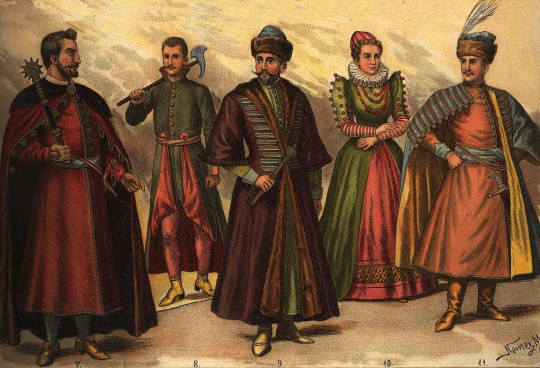
If you zoom in on the costume's coat, you'll see floral patterns created out of the negative space of surrounding gold embroidery. As a "similar" thing in terms of floral embroidery made of precious metal thread, we have Leopold I's dolmány, made in Italy but produced in Hungarian style. On the right is another example from the same time period of golden floral embroidery, which could be purchased directly in the Ottoman Empire and then further sewn or altered in Hungary/Wallachia/wherever.
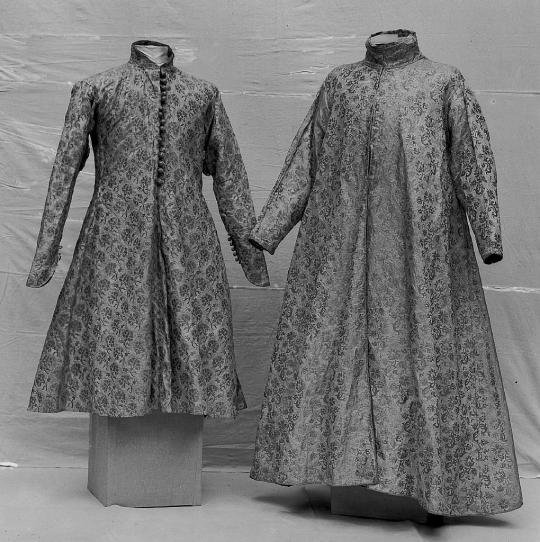

I know I just used one Polish example, but there's a ton of upper class male fashion from this time period that looks like this from there, Ukraine, the Balkans, etc. because that's the region where this stuff was popular. Obviously it should all be brought back immediately. This is why the movie costume looks like that--it's specific to a particular time and place, calling back to where Vlad the Impaler came from and where Bram Stoker got his general inspiration and vibes from, only a couple hundred years after Vlad actually lived.
“If it should be, and he came to London, with his teeming millions. … There may be a solemn duty; and if it come we must not shrink from it.”—Bram Stoker, Dracula
A vampire must avoid direct sunlight to avoid crumbling into ash, yet few folk horrors have been subject to more scrutiny than the transformative bloodsuckers who dominate the night. A new and absolutely terrific cinematic take on the myth, Robert Eggers’ Nosferatu, has hit theaters, and its most notable element, in addition to outstanding performances, dialogue, and production design, is that this new version really amps up the lusty goth quotient. (So much hallucinatory writhing and moaning!) However, its release so close to the inauguration of a U.S. president who has stoked fears of immigrants draws out xenophobic elements inherent to the text, and an inner tension with its own reactionary origin is part of the genius of this new film.
If you aren’t a subscriber to Fangoria magazine, you may not know the Nosferatu backstory. The first version, released in 1922, is a landmark of German filmmaking that plundered intellectual property as if it were the grave of a Victorian noblewoman buried with her jewels—a fate some of the characters in Dracula think has befallen poor Lucy Westenra, before it is revealed she is actually an accursed undead demon!
Unlike his most famous literary creation, though, Irish-born writer Bram Stoker does not walk the earth a century after his death. As such, the theater manager who wrote books on the side would likely be surprised at the strength of his legacy. Dracula, published in 1897, was only a modest success at the time. It was not even the first book about vampires published in English; how it became the wellspring for vampire iconography—to the point that is used to sell breakfast cereal—is perhaps due to vivid, dueling film interpretations.
In 1921, a German film producer with an interest in the occult created a new studio (Prana) with an eye toward making supernatural-themed films, and kicked things off with an adaptation of Dracula. He hired Henrik Galeen, who co-wrote the outstanding expressionist The Golem: How He Came Into the World, to write the screenplay, and F. W. Murnau—who would later make Sunrise: A Song of Two Humans, one of the undisputed masterpieces of silent cinema—to direct. But he did not pay for the rights to Bram Stoker’s book. Instead, Galeen changed the names of the characters (Count Dracula to Count Orlok) and the location (London to Wisborg, a fictional German city), and made some additional tweaks to the narrative. The title, Nosferatu, is a word used in Dracula to categorize vampires, meaning undead. (The etymology of this word remains debated, but it may have its roots in the Greek nosophoros, meaning “disease-bearing.”)
Nosferatu: A Symphony of Horror was released to significant acclaim, but one person who wasn’t happily chomping on popcorn was Florence Balcombe, Bram Stoker’s widow. An anonymous informant sent her a handbill from the movie’s lavish premiere at the Marble Hall of the Berlin Zoological Gardens. The promotional material boasted that the film was “freely adapted” from Dracula. Balcombe took this to court, won her case, and bankrupted Prana, which was ordered to destroy every copy of Nosferatu. Clearly, this did not happen, as you can still watch the movie today—and, despite the iffy ethical origins, you should; it’s terrific.
But what Balcombe did next was key. Springboarding off the increased interest in the story (and to guarantee proper payment on copyrighted material), she greenlit a stage production. The show ended up being a hit in London in 1927, then moved to New York later the same year. That version starred Bela Lugosi. Four years later, Lugosi reprised the role for Tod Browning’s film version for Universal Pictures, the first talkie in the Universal Monsters series. It was a sensation, and Lugosi’s sharp-toothed Transylvanian is now an early screen icon on par with Chaplin’s Little Tramp.
Other Dracula movies were soon in the works—a Spanish-language version was actually shot concurrently with Browning’s, using the same sets—and have never stopped. Hammer Studios in Britain made several classics starring Christopher Lee; there’s the Andy Warhol-presented Blood for Dracula; the disco era’s comedy Love at First Bite; Francis Ford Coppola’s stylistic version from the 1990s; and then there’s Adam Sandler’s Hotel Transylvania cartoons. Moreover, Lugosi knew a good gig when he saw it. The actor reprised his role for comedy (Abbott and Costello Meet Frankenstein—and also the Count!) and special appearances (a gig on Fred Allen’s top rated Texaco Star Theater radio show is just one example), and also starred in several Dracula-esque horror titles like The Devil Bat. While Lugosi’s lines from Dracula were instantly quotable (“I never drink … wine” is certainly my favorite), behind it all was the less hokey, dreamlike silent film version of Nosferatu, sprung from illicit origins and filled with striking sinister imagery.
Shadow of the Vampire, released in 2000, imagines that the original production was cursed because actor Max Schreck, who played Count Orlok, was truly a vampire. (Willem Dafoe was nominated for an Oscar for his performance of Schreck in this behind-the-scenes comedy, which is especially amusing because he plays the part of Prof. von Frantz, a spin on Stoker’s Dr. Van Helsing, in the new film.) Shadow of the Vampire’s premise—the cover up of an unsettling (fictional) aspect of the original Nosferatu—works because, while the intentions of Murnau and company are hard to know, it is easy to see how German audiences of the 1920s could read Nosferatu as antisemitic.
The film and its source material read like a laundry list of antisemitic tropes: The Count comes from “the East,” a backwards, superstitious land. (Transylvania, while certainly a real place, means “beyond the woods.”) He has somehow amassed a fortune despite living apart from the villagers who fear and despise him. He is a non-metaphorical bloodsucker. When he gets to civilization, he immediately starts preying on women. In most versions of the story, the first woman he assaults turns into a vampire herself, then starts draining the blood of babies and children, recalling the many examples of supposed blood libel used to excuse antisemitic violence throughout the previous centuries. When the character of Mina Harker (called Ellen Hutter in Nosferatu) is finally penetrated by the count, she declares that her blood is “unclean.” The Count’s curse demands that he sleep each night in the earth of his origin, but he comes up with a sneaky loophole by packing several coffins filled with Transylvanian dirt. One way to interpret the Count’s actions is metaphorical: The immigrants are unwilling to assimilate and they taint our family lines and drag their traditions along with them from the old country. But on a much more literal level, it is quite bluntly blut und bloden, blood and soil, a Nazi rallying cry since the 1920s that, unfortunately, persists to this day.
While these symbolic plot elements exist in the 1897 novel, it was the 1922 German film that dialed them up, adding some undeniable antisemitic visual tropes. Count Orlok, compared to the Spirit Halloween-ready Count Dracula, has a hooked nose and rodent-like clutching hands, an exaggerated reinterpretation of the Count’s features compared to how they are described in Stoker’s book. (Lugosi’s Dracula from 1931 eases up on the visual stereotypes considerably, but he does wear a six-pointed star the first time we see him.)
Murnau also added a plague element to Nosferatu’s storyline. When the Count’s ship comes to Wisborg, it arrives with rats and a rapidly spreading sickness. This “verminization” goes hand-in-hand with the notion of the “dirty Jew.” It is believed that Julius Streicher, editor-in-chief of the Nazi mouthpiece Der Stürmer, was a fan of the film, and Hitler himself, in Mein Kampf, compared Jews to vampires.
So hold on a second, you are telling me that a major motion picture studio has released a work of antisemitic propaganda, and it’s in theaters right now? Do I need to send an angry letter? No, not at all. Please do not cancel Robert Eggers, one of the more brilliant directors on the scene today, whose take on Nosferatu tamps down the antisemitism. (This is his fourth film, following The Witch, The Lighthouse, and The Northman, all very sharp plays on genre storytelling, and all worth watching.). Now, Count Orlok just has a weird and striking nose, not a hook nose. He is also less of a schemer. He is compelled to come to Wisborg, as if it is part of his burdensome curse. If one were to ask, “Why make this movie again?” I’d say that, apart from the exemplary sets and performances and cinematography, Eggers emboldens the supernatural, psychosexual connection between the Count and Ellen. Yes, the town leaders of Wisborg—ostensibly the heroes—remain understandably xenophobic. But Eggers adds a top layer of tragedy, by making the subtext text: The Count and Ellen should be able to get their telepathic freak on, but the social codes of the 1830s are so stifling that even the Prince of Darkness can’t fight them. This creates a tension to the story (and its anti-immigration strain) that feels entirely new.
Considering that hardly anyone watching the new Nosferatu will be unfamiliar with vampire tropes, Eggers is well within his rights to essentially copy-paste elements from the more problematic version and build on it. The added shading, leaving the audience wondering if maybe the Count isn’t such a villain, is enough nuance to keep this from feeling like a definitive political statement. After all, the first thing you’ll likely talk about after seeing it is Ellen’s (Lily-Rose Depp) several moments of bed-ridden, prurient murmuring “he’s coming!” from a dream-like haze. For a director who has made three sharp movies dealing with the supernatural or fantastic, this story is in Eggers’ blood.
10 Vampire Streaming Recommendations
Nosferatu: A Symphony of Horror (1922), dir. F.W. Murnau: The original nightmare.
Dracula (1931), dir. Tod Browning: The birth of a franchise. Warning: Though there are many classic moments, much of this movie is dull.
Dracula Has Risen from the Grave (1968), dir. Freddie Francis: The third Christopher Lee Dracula picture, and one that likely influenced the new one—as it was, for its time, a bit on the randy side.
Blacula (1972), dir. William Crain: An 18th century African prince is transformed into a vampire by Count Dracula himself, and ends up in 1970s Los Angeles. Released during the first wave of blaxploitation films, this was the first one to get supernatural.
Love at First Bite (1979), dir. Stan Dragoti: The Count comes to groovy New York and is faced with nonstop schtick. Richard Benjamin plays the famed vampire hunter Van Helsing’s grandson, a neurotic shrink named Dr. Jeffrey Rosenberg.
Nosferatu the Vampyre (1979), dir. Werner Herzog: Before Eggers, there was this German-language take focusing on Count Orlok. A slow-paced film that goes heavy on the plague storyline, featuring a substantial number of rats.
Bram Stoker’s Dracula (1992), dir. Francis Ford Coppola: Gen X Dracula, with Winona Ryder, Gary Oldman, and Keanu Reeves.
Thirst (2009), dir. Park Chan-wook: Not a Dracula film, but an unpredictable spin on the vampire myth from one of South Korea’s great filmmakers.
Only Lovers Left Alive (2013), dir. Jim Jarmusch: Cinema’s king of deadpan cool presents artists and rock musicians as vampires eternally on the fringes of society. (A documentary?)
El Conde (2023), dir. Pablo Larraín: Perhaps of particular interest to Foreign Policy readers, this Spanish-language picture, available on Netflix, suggests that Augusto Pinochet was actually a vampire, and takes it from there.
#So a big issue with his order was that he gave them the length he wanted in units from Belgrade that they were ??? about in Constantinople#Apparently the artisans asked around but everyone had a different answer for how long this Belgrade length was supposed to be so... *shrug*#The guy also forgot to say what color he wanted so his intermediary basically wrote “what color pls respond” as respectfully as possible#Another issue was that the One Person who made big luxurious sashes was pretty old and on her deathbed so she couldn't do it#so a Jewish trader had to write to the people on a Greek island where they made these things and asked them to prepare the fabric#which would be dyed once they reached Constaninople#But they still needed to know how long to make the sash so the intermediary just told them to make it double the length of a normal one#I hope the guy was happy with his sashes once they eventually arrived lol#Back to the topic--#I haven't seen the new movie yet and I'm not sure if I want to#I'm definitely interested but I really can't do body horror so I might have to sit this one out based on the reviews :(#Nosferatu#costumes#long post
109 notes
·
View notes
Text
Kurdish ecology. Indigenous seeds and food heritage. Palestinian edible plant archive. Ezidi foods and reverence for landscapes. The narratives of “exiled foods.” Suryani, Zaza, Kurdish, and Armenian displacement. Okra and mustard greens. Dispossession and native plants in Anatolia and the Mediterranean. Imagining alternative worlds and affirmative care structures. Landscapes breathing in slow, deep time. Seed exchanges and “entanglement of solidarity” across regions in defiance of military surveillance, industrial monoculture, and extraction. “Homeland is not where you were born, it is where you are fed.”
---
Okra is strong and can survive the precarity of exile and migration: it can be found in a Bangladeshi vegetable stand in Rome, an Ezidi camp in Diyarbakır, or a guerilla garden along the highway in Kowloon. Okra is one of the world’s oldest cultivated crops, spread by the processes of colonization and the slave trade from Africa and India to the Mediterranean and westward to the new world. Its versatility makes it well suited for states of dispossession and survival. [...] The colonization and standardization of landscapes is always rooted in controlling the cultivation and erasure of localities. [...] Today, the same region [Anatolia and the Mediterranean] is inundated with wars and oppressions that destroy not only biodiversity but also the intangible heritage of ingredients and their narratives across our earth.
“Survival-with” and “through” is something of an entangled kinship that can be described as migrating ingredients, refugee seeds, and exiled foods. Works by artists Seçkin Aydın and Gülsün Karamustafa deal with forced eviction and exile from their homelands in different historical periods in the last century in Anatolia. Aydın is a Zaza minority from an evicted Kurdish town called Kulp (Diyarbakır Province). His work I can’t carry my grandma, i can also not eat her or wear her (2015) uses the metaphor of Aydın’s grandma keeping small fruits in his pocket during their journey of exile when he was a child. [...]
Karamustafa’s work Heimat Ist Wo Mann Isst (1994) depicts three spoons wrapped in an old cloth. The title means “Homeland is not where you were born, it is where you are fed,” which refers to cross-Balkan and Anatolian transnational migration.
---
Practices of collecting and archiving heirloom seeds are a form of solidarity and resistance against extractive capitalism and industrialized agriculture. Such projects protect and aim to restore natural habitats and biodiversity. They are critical of dominant monocultural approaches [...]. How can we consider a more-than-human ethics around seed and seed heritage? How can we collect cross-narrative assemblages of seed heritage? [...]
Indigenous phenomenologies are essential for tracing food heritage and the ingredients that are tightly connected to local communities of Zazas, Ezidis, Armenians, Suryanis, Kurds, and others who are continuously exiled by force in the ongoing extracted landscapes of the Tigris. Often with colleagues we find ourselves discussing, for example, the giyayê xerdelê (mustard greens) that can be easily foraged in the hills of Heskîf, a millennia-old archeological heritage site that has almost been destroyed by the nearby Ilisu Dam, which justifies the expropriation of lands from Kurdish villages and from many nomadic shepherds who were forced to leave. Military surveillance of farmers and of the common grazing grounds of Ezidi, Suryani, and Kurdish villages leads to a loss of the network [...].
Kurdish ecology activists Bişar İçli and Zeki Kanay, who were banned from their municipality and their university positions by the Turkish government in 2017, started an agro-ecological solidarity commune in Diyarbakır. They archive, exchange, and create networks of seeds around the Tigris River basin, producing an entanglement of solidarity infrastructure among Kurdish communities against military surveillance and capitalism-led extraction in this region.
---
Cineria, an Ezidi village near Batman, Turkey, was nearly emptied out in the 1980s due to conflict in the region between the Kurdish movement and the Turkish state. [...] Soil, stone, rocks, caves, and water are fundamental cosmological elements of Ezidi cultural practice connecting the past, present, and future. Each year the village hosts semi-nomadic Zaza shepherds who migrate from another southeastern Turkish city, Bitlis [...]. The Ezidis accommodate the shepherds for six to seven months in Cineria; both communities communicate using the Kurmanji language. [...]
Long walks through landscapes are a basic practice of Ezidi women, where they learn about the land and the cultivation cycle connected to Ezidi cosmology, which is about keeping and protecting ingredients, seeds, and healthy soil. Honouring nonhuman elements is fundamental to Ezidi cosmology. As Ezidi women walk through the landscape, they tell stories of dispossession, mourn for lost soil and seeds, and whisper continously: “av, agîr, erd, ba, roj.” [...]
---
Palestinian geographer Omar Tesdell, who created the Palestinian edible plants archive, tells us that landscapes move in slow, deep time, and that all wild plants, seeds, and healthy soil are our heritages. These heritages will not only support our precarious societies but may create an ethical, responsible entanglement of resilient coexistences for our collective future. [...]
Following an okra plant through narratives, infrastructures, forgotten languages, and entangled exiles is not a metaphor. As artist Jumana Manna writes, we strive toward “imagining alternative/affirmative care structures that remain, within and beyond the current reality, aligned towards plant and human life alike.” Navigating through migrating ingredients, refugee seeds, and exiled foods, we witness and learn about extractive strategies, state-making, and slow violence.
---
Text above by: Pelin Tan. “Entangled Exiles.” e-flux (journal). Issue 131. November 2022. [Some paragraph breaks/contractions added by me. Italicized first paragraph/heading in this post added by me. Presented here for commentary, teaching, criticism purposes.]
#ecologies#multispecies#tidalectics#abolition#indigenous#indigenous pedagogies#black methodologies#opacity and fugitivity#entangled exiles#mesopotamian ecology#geographic imaginaries#exiled food
292 notes
·
View notes
Text
the thing is to be very clear too i don't mean this in any sort of "islam is the only religion or culture or etc which has some sort of particular issue with this" way. at all
the very very very old ancestors of my people came to the balkans from most likely central asia and mixed with the indigenous population. they were patriatchal, and practiced polygamy, and the idea was that powerful men needed like at least ten wives to be satisfied. this is as far back as my peoples history can be traced, and women were still treated like property of men and sex-things. and after that? well, centuries on end of women and girls being seen as property to be traded and sold, sex slaves, bridal kidnapping, child marriages, domestic abuse and rape being common, etc. christianity brought its own flavour. islam broutht its own flavour. but. like. there are parts of the world which can, because they werent patriarchies. but i really can't blame either christianity or islam for the patriarchal system my people have held and the endless crap endured
like. its often painted as this so thats why im saying it. islam isnt some sort of unique thing in its history twoards these sort of things. men taking girls as child brides and sex slaves and everything else that surrounds this, is very much a cross-cultural, historical, very widespread issue among humans
8 notes
·
View notes
Text
it drives me so. incredibly insane reading western anthropological studies about "sex work" prostitution in western europe, it truly does, because 99% of them are written from this god forsaken postmodern narrative
nevermind the cruelty and dishonesty in them so often //barely// bringing up the poverty in the balkans, and that its not just our women being trafficked and horribly exploited but our men as well. nevermind the dishonesty in the idea that this mass migration is somehow a "choice" and whatnot. nevermind that noone wants to point out that economically&racially there is something incredibly fucked abt the dynamic of the entire situation, us being hated by the westerners while our cheap or alltogether uplayed labour keeps western europe running, while in many brothels its ~/+80% romanian and bulgarian/other balkan women. nevermind that this whole choice narrative is not only privileged but it just leads to incredibly lacking science
but. i find it. truly vile and disgusting that these "social scientists" genuinely do not give a single shit about our women, not at all, not even with 0.5% heart and soul. truly downright morally bankrupt and just. disgusting.
how the fuck can you even write this shit. and completely ignore and not bring up the undeniable massive sex slave trade of balkan children that's being directly fuled by the legalization of "sex work." how can you not bring up that the sex traffickers who "help women migrate for legitimate sex work" are th exact same ones who traffick minor girls and produce child pornography. how can you not bring up and care at all that so many already-traumatized refuggee women and girls are being dragged into this fucking nightmare all the time
you know HOW many cases there are of romanian, moldovan, balkan women being sex trafficked? sexually enslaved? tortured in every god awful unimaginable way? having bar codes and numbers tattooed and branded on their skin?? how many cases there are of balkan girls under 17 being raped several times, sold several times, tortured, even killed? how in romania you cant watch the news without hearing of more and more of our minor girls and women being rescued from some other horrific sexual slavery situation in the west??? how here police departments and the government are involved in trafficking minor girls? how foreign men move here to become pimps or rape children?? how, once again, there is case after case of our women being fucking sexually enslaved and tortured???? in large part directly because of this fucking ideology??? how, how, how, xyz every other horrific fucking thing???
how? how can they ignore this. how can these god damned good for nothing "social scientists" ignore this (they dont give a shit abt us and theire privileged and brainwashed). but how can they lack the...... the BASIC fucking Empathy??? How can they write this bullshit and not care how many of the women they talked to were molested as children, started working before 18, were raped before or after they were interviewed, were beaten after they talked to them or got hooked on drugs or sex trafficked again or tortured or killed?? there was this one study that 7/10 moldovan sex trafficking victims left because they were being domestically and sexually abused by male family member - does that matter maybe?? how can they not care of their ptsd, of their exhaustion, of their physical pain????
it truly. disgusts me aint even enough of a word, but it does. it makes me sick to my fucking stomach, the absolute lack of basic empathy and care and especially sense of responsibility these female western anthropologists feel for us - especially considering how mant of these women are 17-19, so, young as hell - when all of this is in large part the fault of the ideology they helped create and spread in the first place anyway. their most basic lack of care makes me vomiting levels of upset and angry.... and again, worse of all.... even if we buy their bullshit choice narratives.... could they PLEASE care that outside of theoretics they're writing about one of the worlds biggest and most profitable child sex slave trafficking currents? please?? lord help us
8 notes
·
View notes
Text
Drago Bludvist’s Origin Story
As we all know, Drago Bludvist is a victim of the ‘ambiguously brown’ trope, due to the writers inability to commit to a specific culture. He’s described as having Slavic, Asian, Mediterranean and North African influence in his design; all of which are disparate areas with multiple cultures. However, there is one potential melting pot where all four of these areas mixed geographically or via trade/war/slavery, which in the Viking age would’ve been the Byzantine Empire.
Now to narrow it down even further. Drago’s spiel about how his village was destroyed by dragons and he’s out for revenge…should be taken with a grain of salt, since he had every reason to lie. His exact words, however, are “my village, burned. My family, taken.” Now to me, that’s an odd word to use. If they didn’t want to have him say “killed”, why not have him say “lost” or “gone”?
What if there’s a grain of truth to his story? What if his village was burned and his family was taken…not by dragons, but by soldiers? Here’s where things get interesting. The Byzantine Empire had slaves, and according to Wikipedia: “After the 10th century the major source of slaves were often Slavs and Bulgars, which resulted from campaigns in the Balkans and lands north of the Black Sea.” So assuming it’s the 11th century, that lines up with the Viking era.
“The Bulgars were Turkic semi-nomadic warrior tribes that flourished in the Pontic–Caspian steppe and the Volga region during the 7th century. They became known as nomadic equestrians in the Volga-Ural region, but some researchers say that their ethnic roots can be traced to Central Asia.”
There’s the Mediterranean and Asian influence. The Bulgars went on to found the found the Bulgarian Empire in, well, Bulgaria, which is in the Balkans. What else is in the Balkans? Slavic countries. If you want to include African influence, maybe Drago could have mixed heritage in his parents or even grandparents.
I really do think Drago being a Bulgar who was enslaved by the Byzantine empire fits his character almost perfectly. It’s not much of a leap to go from ‘warrior on horseback’ to ‘warrior on dragonback’, it gives him a plausibly tragic backstory as motivation, and he must have gotten the idea to build an empire and/or conquer the known world from somewhere. Why not like this?
TL;DR - my headcanon is that Drago Bludvist was born in Bulgaria to mixed heritage parents (Turkic & African), enslaved in the Byzantine Empire, at some point found a young Bewilderbeast and used it to escape (possibly losing his arm in the process), only to abuse it into obeying so he could start conquering.
67 notes
·
View notes
Text
You will hate me for historical facts. And call me names.
What's something that sucks about being white?
Olzhas Yessenbayev
, Studied philosophy of history
Updated December 24, 2017
https://www.quora.com/q/worldhistory?__ni__=0&__nsrc__=4&__snid3__=6456142643&__tiid__=5166533&sort=top
Quick disclaimer here: I am not White. I am not European. I am Asian, and I come from such a part of the world where History lessons are not tied up with Identity Politics and the concept of “White Guilt”. So perhaps you will be a bit shocked.
If you are white, everyone will accuse you of racism, oppression, cultural appropriation, sexism, homophobia, Islamophobia - every sin in the world, even though you by all standards are better than 95 percent of the world.
What’s about slavery?
Did you know that slavery existed throughout the entire history of human beings? Europeans were also held as slaves - not only in Ancient Rome, but also quite recently - by historical standards - as part of the Arab, Barbary and Ottoman slave trades.

In Constantinople (present-day Istanbul), the administrative and political center of the Ottoman Empire, about a fifth of the population consisted of slaves in 1609 - many of whom came from Caucasus, Eastern Europe, and Africa. And yet there is no “Turkish” guilt whatsoever. There is no “Arab” guilt. No one in the Arab or Turkish world has a “White Pride Parade” today, nor are Arabs forced by their educational system to cast aside their glorious history and deride their ancestors for slavery.
You can read the same about Slavery in muslim Spain, in Iran, and so on.
Slavery was ubiquitous until it was ended in the 20th century. By Europeans.
What’s about “colonialism”?
Did you know that it also existed pretty much everywhere in the world?

Here, you can see, that almost a third of the European continent was once a place conquered by the Islamic states, let alone the Islamic conquest of the North Africa. Why no one speaks of Islamic colonialism and Islamic guilt?
Colonialism was ubiquitous until it was ended in the 20th century. By Europeans.
Life was a mess before the 20th century - pretty much everywhere in the world. The whole concept of human rights, that we today take for granted, did not at all exist until it was established by Europeans.
I am by no means claiming that Europeans are - or were - holy.
It is just that everything bad that is ascribed to Europeans - colonialism, racism, slavery, sexism - was ubiquitous everywhere in the world, until it was ended by Europeans. It is just that Europeans were more successful at doing these things.
So please, stop hating your(European) history and take pride in it - just as everyone else in the world does. Every history of every race and ethnicity has its bright and its dark moments. Let’s forget what is long gone and look forward to a world where no such things will exist - only beautiful moments!
#history#islam#colonialism#slavery#arabs#europe#north africa#spain#romania#balkan#ottoman empire#facts#islamic slave trade#islamic colonialism
0 notes
Note
[Huey Zoomer Anon]
Side note I’m not saying we should massacre the Benin or any other tribes who were part of the transatlantic trade
Though I meant put my foot up the certain people asses who want reparations or say the bronze items they use to pay for slaves should return to Africa
Nope, that shit staying in the Americas just like me. Want me to true a pure American tank if you try?
And Asian and Arab imperialism, wait didn’t we defeat one about 80 years ago? Wait the Ottoman Empire and Abssaud Caliphate didn’t exist in real life? Then where the fuck is instabul and Baghdad is at?
I think people really need to understand HOW corrupted academia can be. Keep in it was high quality schools that taught white boys and girls in the Victorian era to see non white people less than human
That whole thing with the bronzes was absurd and even activists here told them as much,
then this
Why are they asking anyone other than themselves for reparations here, who do they think sold the slaves to the slave traders.
The 'my brother in Christ we already paid you for them' line is both funny and true.
Maybe they should try their luck with Egypt, Iran, Morocco, and so on and so on.
Should send a bill to the palestenian authority too, since they did a bunch of slave trading through the ports in palestine when it was under Ottoman control as well as the other caliphates that steamrolled over the local population.
Several billion dollars just sitting there since the grafters that were in charge of hamass are now pig food, take their money.
Video I was telling you about a couple days ago, filming kids in Saudi Arabia who's parents were rich and you notice the kids aren't carrying their schoolbooks because their slave that their parents bought them carried those for them, this was in the 60's. 1960's mind you not 1860's though it was happening then too.
Let's get the Balkans involved too,

Ismail Enver is better known as Enver Pasha, one of the three pasha's, he's got as much responsibility for the Armenian genocide as it's possible to have.
So pro slavery and pro genocide, real winner there.
So Turkey and really any of the former Ottoman territories will owe the nations of the Balkans reparations for taking their sons and forcing them to fight their wars and taking their daughters and forcing them to be in their harems, and everything else they took slaves from that area from.
I think people really need to understand HOW corrupted academia can be. Keep in it was high quality schools that taught white boys and girls in the Victorian era to see non white people less than human
ya it's nuts, now we have folks in academia teaching the inverse of that, because somehow it's ok when they do it instead of just saying racism is evil like they should.


The fight was to be seen as equal, not superior.
Not sure how that message got lost.
2 notes
·
View notes
Text
youtube
Facts about slavery never mentioned in school | Thomas Sowell
“The instrumental use of the history of slavery today also underlies the claim that slavery grew out of racism. For most of its long history, which includes most of the history of the human race, slavery was largely not the enslavement of racially different people, for the simple reason that only in recent centuries has either the technology or the wealth existed to go to another continent to get slaves and transport them en masse across an ocean. People were enslaved because they were vulnerable, not because of how they looked. The peoples of the Balkans were enslaved by fellow Europeans, as well as by the peoples of the Middle East, for at least six centuries before the first African was brought to the Western Hemisphere.
Before the modern era, by and large Europeans enslaved other Europeans, Asians enslaved other Asians, Africans enslaved other Africans, and the indigenous peoples of the Western Hemisphere enslaved other indigenous peoples of the Western Hemisphere. Slavery was not based on race, much less on theories about race. Only relatively late in history did enslavement across racial lines occur on such a scale as to promote an ideology of racism that outlasted the institution of slavery itself.”
How much of this did you know?
I knew some of it, including the fact while the Transatlantic slave trade had higher peaks, Islamic countries took far more slaves over a much longer period... including Europeans. A fact nobody wants to acknowledge, solely for intersectional reasons.
Not only that, but the Islamic empires forcibly castrated their male slaves. If you wonder why the descendants of those slaves aren't looking for "reparations," it's because there aren't any.
What's most remarkable though is the US's parochial, navel-gazing view of itself as a bizarre form of exceptionalism.
Reaction videos:
youtube
youtube
#Thomas Sowell#slavery#history#history of slavery#American history#Black Rednecks and White Liberals#religion is a mental illness
52 notes
·
View notes
Note
Did the Ottoman Empire ever express interest in establish colonies in the New World? Or were they content to let the Christian powers of Europe squabble over the land there while they made inroads into Africa?
Not to my knowledge.
The primary reason was that it wasn't very necessary. The Ottomans controlled the land and sea trade routes for silk and spices, so they didn't need to go west toward the New World. One of the reasons why the European powers sailed west was to find new routes to bypass the Ottoman stranglehold on those routes. No need to do that if you are the one with the monopoly on those trade routes. That's the same reason Venice and Genoa never really needed to colonize the Americas.
Second, the Ottoman Navy was primarily a galley navy. While the Ottomans did have a naval presence in the Indian Ocean (and fought with the Dutch and the Portuguese for naval supremacy), the Ottomans elected not to invest significantly in a large ocean-going navy like the Portuguese Empire, but to establish a powerful galley navy that would secure control of the Mediterranean. Couple that with less access to the Atlantic Ocean, and you can see why the Ottomans wouldn't be looking at the New World. The Ottomans did have activity in the Atlantic, but this was primarily to raid northern and western Europe for plunder and slaves.
Third, and related to the second, was that the Ottoman's primary method of expansion was land conquest, into the Balkans, into Africa. The army drew a significant amount of military investment, to both keep up the strength of their army and devote manpower to maintaining control of their conquests in Eastern Europe, the Middle East, and North Africa, against the myriad enemies - Austria, Hungary, the Mamluks, the Polish-Lithuanian Commonwealth, Safavid Persia, Russia, etc.
Thanks for the question, Anon.
SomethingLikeALawyer, Hand of the King
29 notes
·
View notes